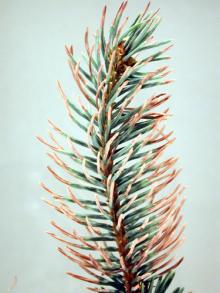See:
Hemlock (Tsuga spp.) - Phytophthora Root Rot
Cause The fungus-like microorganisms Phytophthora cactorum and P. cinnamomi have been reported on spruce, but it generally is considered a tolerant plant and grows in spite of root rot. Nevertheless, the OSU Plant Clinic has diagnosed it regularly. Root rot is a problem when plants are in containers or areas with poor drainage or flooding. The pathogens survive as spores in the soil, organic debris, container media or infected tissue. Root infections occur in the spring when soils are at or near saturation. Infection can also occur through pruning wounds.
Seedlings of Sitka spruce (P. sitchensis) and Engelmann spruce (P. engelmannii) were considered tolerant when challenge inoculated with 5 species common in forest nurseries: P. cactorum, P. cryptogea, P. drechsleri, P. megasperma and P. pseudotsugae.
Symptoms These organisms attack the roots, which rot and die. The infection moves up into the root crown, where the vascular cambium (soft inner bark) turns reddish brown instead of the normal greenish white. Trees may show wilting, branch dieback, or other symptoms of inhibited water and nutrient uptake.
Cultural control
- Avoid soil compaction, which reduces drainage. Construction, heavy foot traffic, or machinery can cause soil compaction.
- Improve soil drainage by incorporating organic material or using raised beds.
- Prevent disease by planting only pathogen-free materials in uninfected soil.
- Remove and destroy all infected plants and plant debris.
- Avoid reusing pots from a previous crop for propagation. If pots must be reused then wash off all debris and soak in a sanitizing solution or treat with aerated steam for 30 min.
Chemical control If needed, use fungistatic compounds. Use fungicides as preventative treatments. The Group 4 and P7 fungicides used to manage Phytophthora do not kill this organism. They can only prevent establishment of the organism before it gets into the plant. They can also prevent continued growth if the organism is already inside the plant thereby delaying symptoms that might have developed. Once chemical activity has subsided with time, the organism can resume growth within infected plants. Rotate fungicides that have a different mode of action for resistance management.
- Aliette at 2.5 to 5 lb/100 gal water as a foliar spray. Do not use with adjuvants. Group P7 fungicide. 24-hr reentry.
- ArborFos is registered for tree injections. The number of capsules used is based on tree size. Group P7 fungicide.
- Areca at 2.5 to 5 lb/100 gal water as a foliar application. Group P7 fungicide. 12-hr reentry.
- Fosphite at 1 to 2 quarts/100 gal water. Do not use copper products within 20 days of treatment and do not use spray adjuvants. Group P7 fungicide. 4-hr reentry.
- Monterey Garden Phos at 2 to 4 teaspoons/gal water as a foliar spray. Also labeled for soil drench, see label for details. Can be used in landscape sites. Group P7 fungicide. H
- Phospho-Jet at 1 to 2 quarts/100 gal water as a soil drench. Group P7 fungicide. 4-hr reentry.
- Rampart at 1 to 2 quarts/100 gal water/A. Can also be trunk injected. Group P7 fungicide. 4-hr reentry.
- Subdue MAXX is not specifically registered for spruce but can be used if not phytotoxic to the plant. Group 4 fungicide. 48-hr reentry.
- Tourney EZ at 1 to 4 oz/100 gal water. Group 3 fungicide. 12-hr reentry.
Reference Campbell, S.J. and Hamm, P.B. 1989. Susceptibility of Pacific Northwest conifers to phytophthora root rot. Tree Planters' Notes 40:15-18.





